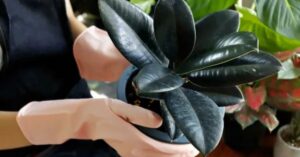Hydrangea trees change any plant into a shocking exhibit of colorful blossoms. These wonderful blossoming examples aren’t your ordinary bush assortment – they’re prepared into tree shape, making sensational central focuses that take the appear. Whether you’re managing with a paniculata or arborescens assortment, legitimate care makes all the distinction.
Victory with hydrangea trees pivots on understanding their interesting needs. They pine for steady dampness but loathe waterlogged roots. The proper adjust of daylight and shade keeps them flourishing all through the seasons.
From pruning procedures to soil inclinations, caring for these wonders requires particular information. You’ll find that little alterations in your schedule surrender marvelous comes about. With the proper approach, your hydrangea tree will remunerate you with breathtaking shows year after year.
Choose the Right Location
Your hydrangea tree’s future depends on smart placement decisions. Morning sun with afternoon shade creates the perfect environment. Too much direct sunlight scorches delicate petals and leaves.
Wind protection matters more than most gardeners realize. Strong gusts damage branches and dry out soil quickly. Plant near fences or larger trees for natural windbreaks. Good air circulation prevents fungal diseases without creating harsh conditions.
Types of hydrangea tree
- Hydrangea paniculata – Hardy varieties that bloom on new wood
- Limelight – Cream flowers turning pink in fall temperatures
- Little Lime – Compact version perfect for smaller gardens and containers
- Pinky Winky – White blooms with deep pink tips creating stunning contrast
- Fire Light – Rich red stems with white flowers aging to burgundy
- Hydrangea arborescens – Native species with reliable summer blooms
- Annabelle – Classic white snowball flowers reaching impressive sizes
- Incrediball – Stronger stems supporting larger, heavier flower heads
- Invincibelle Spirit – Pink blooms supporting breast cancer research programs
- Lime Rickey – Chartreuse flowers fading to white throughout the season

Soil Requirements
Well-draining soil keeps your hydrangea tree healthy and happy. Heavy clay suffocates roots while sandy soil drains too fast. Mix compost into existing dirt for the ideal texture.
pH levels directly affect bloom colors in certain varieties. Acidic soil produces blue flowers. Alkaline conditions create pink blooms. Test your soil annually and adjust accordingly. Most hydrangea trees thrive in slightly acidic conditions between 6.0 and 7.0.
Read more : How to Care For a Fiddle Leaf Fig and Keep It Thriving
Watering Tips
Deep, infrequent watering builds strong root systems. Shallow daily sprinkling creates weak, surface roots. Water slowly at the base to reach deeper soil layers.
Morning watering gives plants time to absorb moisture before heat arrives. Wet leaves at night invite fungal problems. Check soil moisture two inches down with your finger. Dry soil means it’s watering time.
Fertilizing the Right Way
Balanced fertilizer feeds your hydrangea tree without overstimulating growth. Too much nitrogen produces lots of leaves but fewer flowers. Apply slow-release granules in early spring for steady nutrition.
Compost provides gentle, long-lasting nourishment throughout the growing season. Spread a two-inch layer around the base each fall. Organic matter improves soil structure while feeding beneficial microorganisms that help your tree thrive.
Pruning Techniques
Timing determines whether you’ll have blooms next year. Old wood bloomers need pruning right after flowering ends. New wood varieties can handle late winter cuts without losing flowers.
Remove dead, damaged, or crossing branches first. Then shape for better air circulation and appearance. Clean, sharp tools prevent disease transmission. Make cuts just above healthy buds at a slight angle.
Protecting from Pests and Diseases
| Problem | Signs | Treatment | Prevention |
| Aphids | Tiny green bugs on leaves, sticky honeydew | Spray with insecticidal soap or need oil | Encourage beneficial insects, avoid over-fertilizing |
| Spider Mites | Fine webbing, yellow stippled leaves | Increase humidity, use matricide spray | Regular watering, avoid drought stress |
| Scale Insects | Brown bumps on stems, yellowing foliage | Apply horticultural oil treatment | Monitor regularly, prune affected branches |
| Powdery Mildew | White fuzzy coating on leaves | Remove affected leaves, improve air circulation | Plant in sunny spots, avoid overhead watering |
| Leaf Spot | Brown or black spots on foliage | Apply copper fungicide spray | Water at soil level, clean up fallen leaves |
| Root Rot | Wilting despite moist soil, black roots | Improve drainage, reduce watering frequency | Plant in well-draining soil, avoid overwatering |
| Rust Disease | Orange spots on leaf undersides | Remove infected leaves immediately | Provide good air circulation, morning watering |
| Japanese Beetles | Chewed leaves with lacy appearance | Hand-pick or use beetle traps | Apply beneficial nematodes to soil |
Mulching and Weed Control
Organic mulch conserves moisture while suppressing pesky weeds. Wood chips, shredded bark, or compost work beautifully around hydrangea trees. Keep mulch three inches from the trunk to prevent pest problems.
Weeds compete for water and nutrients your tree needs. Hand-pulling works best near sensitive roots. Mulch depth of two to three inches blocks most weed seeds from germinating. Refresh your mulch layer each spring for maximum effectiveness.
Seasonal Care Tips
- Spring Tasks – Apply balanced fertilizer when new growth appears
- Early Spring – Remove winter protection and dead plant material
- Mid Spring – Begin regular watering schedule as temperatures warm up
- Late Spring – Add fresh mulch layer after soil completely thaws
- Spring Pruning – Cut back paniculata varieties before buds break
- Summer Maintenance – Deep water during hot, dry periods weekly
- Early Summer – Deadhead spent blooms to encourage continued flowering
- Mid Summer – Monitor for pests like aphids and spider mites
- Late Summer – Reduce watering frequency as temperatures begin cooling
- Summer Shade – Provide afternoon protection during extreme heat waves
- Fall Preparation – Stop fertilizing six weeks before first expected frost
- Early Fall – Collect and compost fallen leaves around the tree
- Mid Fall – Reduce watering as tree enters dormancy period
- Late Fall – Apply winter mulch for root protection in cold climates
- Fall Cleanup – Leave dried flower heads for winter interest and bird food
- Winter Protection – Wrap young trees in burlap during harsh conditions
- Early Winter – Avoid disturbing frozen soil around root zones
- Mid Winter – Check for ice damage and gently remove heavy snow
- Late Winter – Plan next year’s garden improvements and plant additions
- Winter Pruning – Trim arborescens varieties while completely dormant
Frequently Asked Questions
How often should I water my hydrangea tree?
Water deeply once or twice weekly during growing season. Check soil moisture two inches down. Adjust frequency based on rainfall and temperature.
When’s the best time to prune hydrangea trees?
Timing depends on variety. Prune paniculata types in late winter. Trim arborescens right after flowering ends in summer.
Why aren’t my hydrangea flowers changing color?
Only certain varieties change color based on soil pH. White varieties stay white regardless. Test soil and adjust pH for color-changing types.
Can hydrangea survive harsh winters?
Most varieties handle cold well with proper protection. Mulch heavily and wrap young trees. Choose hardy varieties for extreme climates.
How big do hydrangea trees actually get?
Size varies by variety. Compact types reach 4-6 feet tall. Standard varieties grow 8-12 feet. Dwarf options stay under 4 feet.
Conclusion
Caring for hydrangea trees doesn’t require advanced gardening skills. Success comes from consistent attention to basic needs like proper watering, strategic pruning, and seasonal maintenance. You’ll find that small efforts throughout the year create spectacular results when bloom time arrives.
Your hydrangea tree will reward patient care with years of stunning displays. Each variety offers unique characteristics and growing requirements. Understanding these differences helps you provide exactly what your tree needs to thrive in your specific garden conditions.
Transform your landscape with these magnificent flowering trees. Take after these demonstrated methods and observe your hydrangea tree ended up the centerpiece of your cultivate. With appropriate care, you’ll appreciate decades of breathtaking sprouts that improve your open air space and bring delight to each season.




